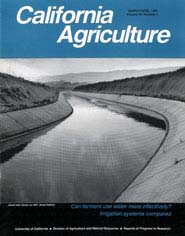All Issues

Can farmers use water more effectively? Irrigation systems compared
Cover:
Canal Near Davis ca. 1967, University of California, Davis. California Museum of Photography Sweeney and Rubin Ansel Adams Fiat Lux collection, University of Caalifornia, Riverside. The photograph is one of the Fiat Lux collection depicting diverse facets of University of California life. UC's agricultural research has been a mainstay of its scientific enterprise for more tham a century.
March-April 1991
Volume 45, Number 2
Volume 45, Number 2





